Amid the pandemic, gardening grew to be a popular means of stress relief and community cultivation, with the added perk of having fresh produce at one’s fingertips. That’s the finding of a survey by UC Davis and UC Agriculture and Natural Resources. Seth Peterson ’96 ’11 can attest to those effects; he’s been gardening for years. And as volunteer manager of UC Santa Barbara’s campus Greenhouse and Garden Project, he’s got great seeds of advice for those looking to get growing:
Gardening 101
Seeking Zen, friends and good food? Get your hands dirty.

Photo by Matt Perko
1. Keep it loose. Generally, vegetables like to grow in loose soil with lots of organic matter, like compost or manure. It may be easier to grow in raised beds or containers with potting soil. Add a sheet of chicken wire under your bed and you’ll avoid gopher predation.
2. Let there be light. Most vegetables require at least eight hours of light each day. Greens are a good option for growing in shadier areas.
3. Mind your seasons. The vegetables at your farmers market were planted about three months before they came in. The two main times to plant things are September/October and April/May.
4. Choose wisely. Grow vegetables that are tastier when homegrown and/or are rare in the store, like heirloom varieties and unusual types. It’s a cliché, but homegrown tomatoes really do taste better, and have you had a carrot fresh from the earth? Lovely. Dragon Tongue green beans are highly recommended; fava beans are great fresh raw, fresh cooked, or dry for storage, and they are good for soil.
Garlic is a great California crop, and there are many varieties (I grow about 20); choose varieties from Spain/France/Italy, which are adapted to our Mediterranean climate. Greens like kale, collards and chard are long-lived and produce a tremendous amount of food.
5. Water less. I try not to water at all in the winter, and only once a week, in the morning, in the summer. You want your plants to develop strong, deep root systems to find water; a side benefit is they’ll find more soil nutrients that way, too. This is for plants in the ground; for container gardening, plants need water two to three times per week.
Peterson, an environmental researcher whose day job is with the geography-based Climate Hazards Center on campus, started his first plot at the Greenhouse and Garden Project in 2008; he has managed the place since 2011. His favorite summer plants are heirloom tomatoes, green beans and shell beans. Winter faves: garlic, fava beans, collard greens, kale and rutabaga.


